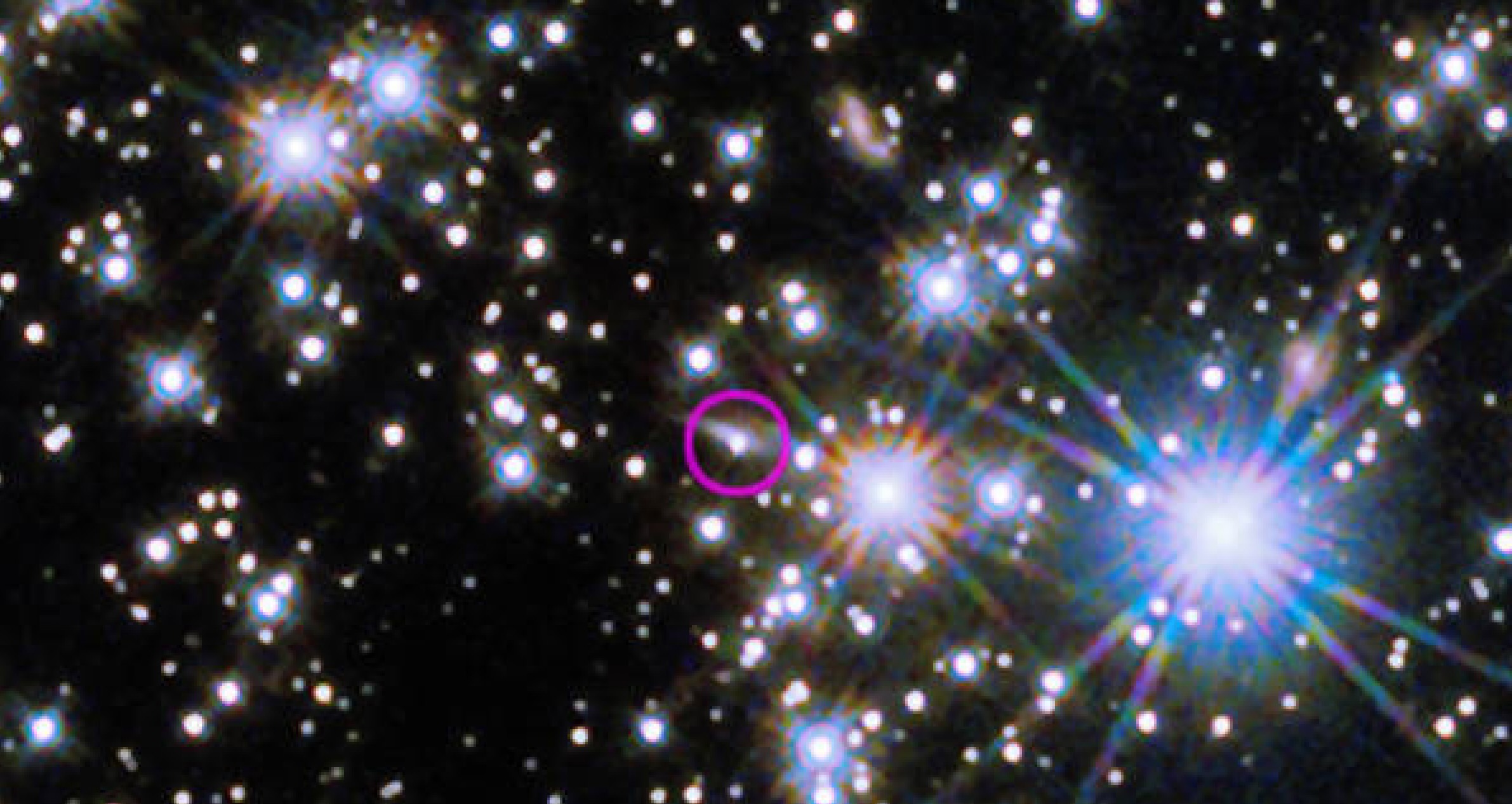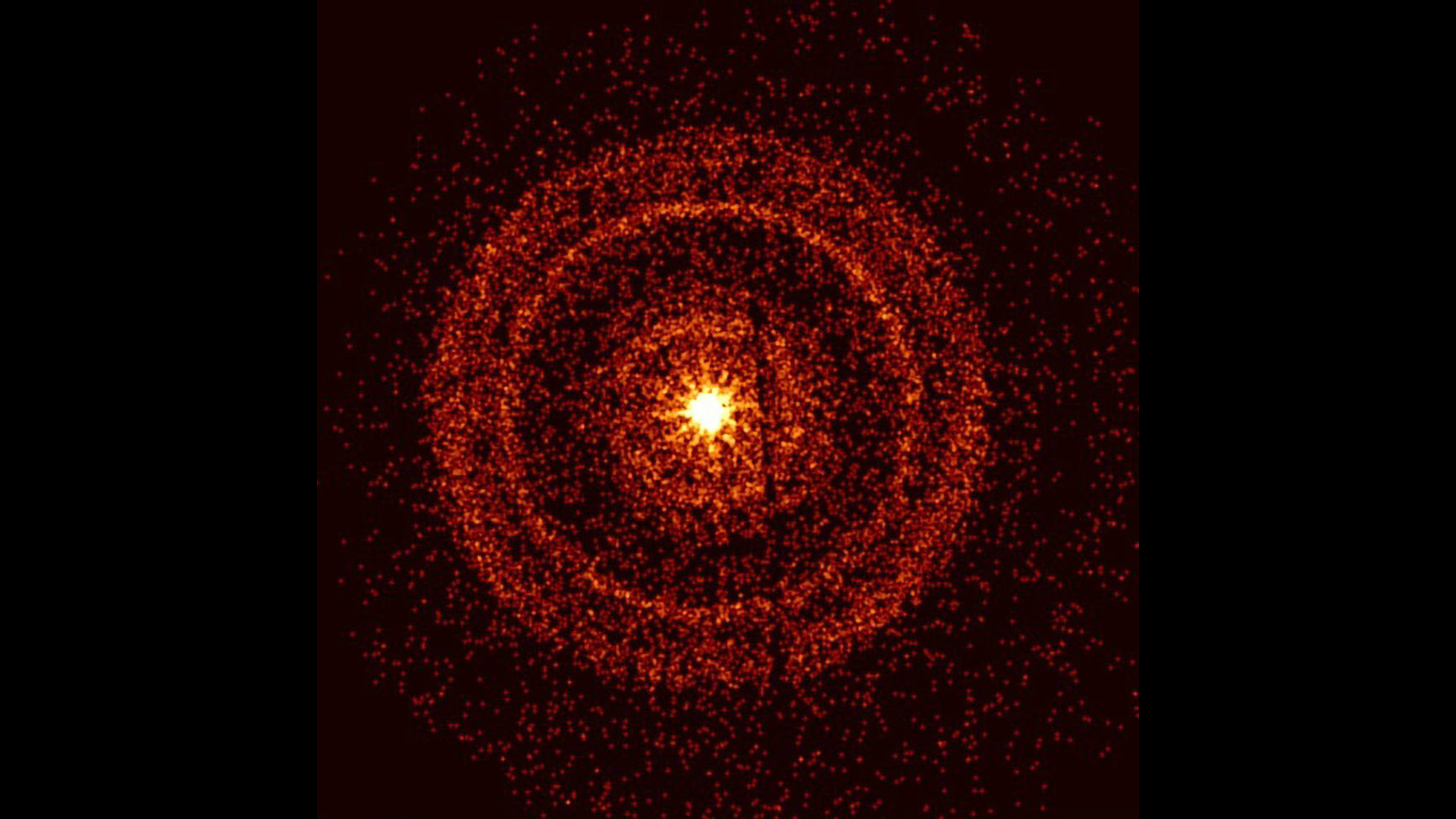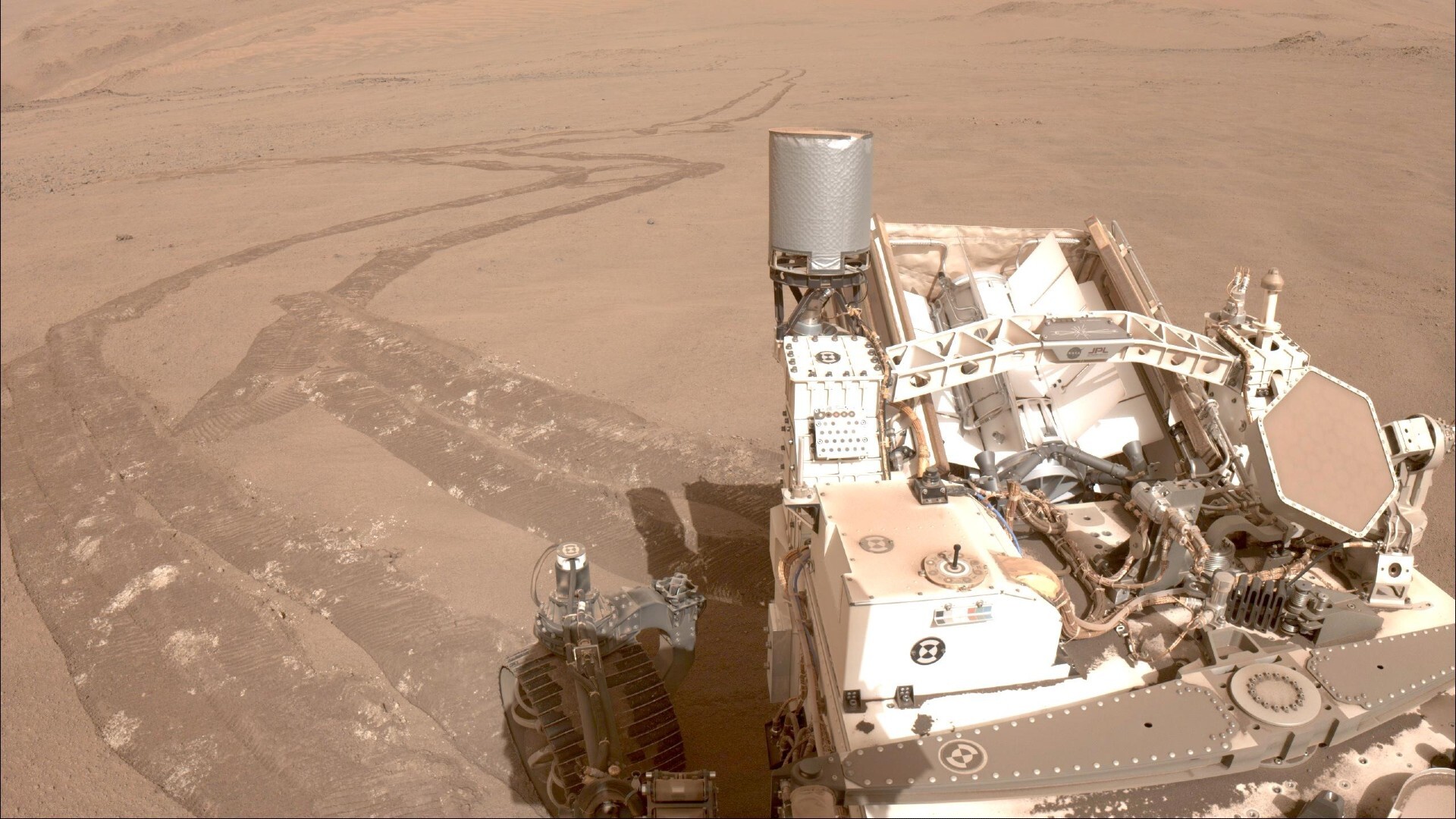What are gamma-ray bursts?
Behold! The most powerful explosions in the known universe — gamma-ray bursts.

Gamma-ray bursts (GRBs) are the most powerful and violent explosions in the known universe. These brief flashes of high-energy light result from some of the universe's most explosive events, including the birth of black holes and collisions between neutron stars.
Lasting a few milliseconds to several minutes, according to NASA, GRBs can be hundreds of times brighter than an average supernova, making them as luminous as a million trillion suns. Thus, when a GRB erupts, it briefly becomes the brightest source of electromagnetic radiation in the observable universe.
The first observation of a GRB came on July 2, 1967, thanks to the Vela 4A satellite, part of a series of X-ray, gamma-ray, and neutron-detecting spacecraft designed to monitor any nuclear testing by the Soviet Union or other nations. The GRB was documented in 1969 and was revealed in a paper published in 1973 after the findings were declassified. Between 1971 and 1973, scientists at Los Alamos National Laboratory examined several GRBs detected by Vela satellites and determined that gamma-ray bursts are indeed "of cosmic origin."
Since then, scientists have been fascinated by these massive cosmic explosions and their sources.
Related: What is a supernova?
"GRBs are cosmic laboratories that allow us to study states of matter and physics that are not reproducible here on Earth," Brendan O'Connor, a postdoctoral fellow at the McWilliams Center for Cosmology at Carnegie Mellon University, told Space.com.
O'Connor, who specializes in the study of massive cosmic explosions, explained that gamma-ray radiation associated with GRBs is produced by a collimated jet of material moving at nearly the speed of light — so-called relativistic speeds — which allows scientists to study the emission mechanisms of relativistic particles.
Breaking space news, the latest updates on rocket launches, skywatching events and more!
"The location of gamma-ray bursts within their host galaxy and their surrounding environment informs us as to the formation and evolution of the progenitor system, providing insight into stellar evolution and star formation across the age of the universe," he added.
Gamma-ray burst FAQs
What causes a gamma-ray burst?
The cause of a gamma-ray burst depends on how long it lasts. GRBs that last less than two seconds are caused by the merger of two neutron stars or the merger of a neutron star and a black hole. Longer GRBs, which can last hours, are triggered when a massive star collapses and births a black hole. In both cases, scientists think GRBs result from jets of particles accelerated to around 99.9% the speed of light.
How powerful are gamma-ray bursts?
In just a few seconds, a gamma-ray burst can emit as much energy as the sun will put out over its entire 9 billion-year lifetime, according to Radboud University professor Andrew Levan.
Do gamma-ray bursts happen in the Milky Way?
GRBs seem to be most closely associated with galaxies that are in the midst of intense star formation, a period that our galaxy seems to have matured out of 2 billion to 3 billion years ago. However, the Milky Way is filled with the supernova remnants that mark the deaths of massive stars, indicating that our galaxy was once home to GRBs.
Do gamma-ray bursts detonate like bombs?
Scientists once thought that a GRB "going off" in a host galaxy would kill all life in that galaxy. This idea has been mostly dismissed now because, rather than detonating like bombs, GRBs seem to channel their energy into two narrow beams, like a lighthouse. That doesn't mean they are completely safe, however. The European Space Agency (ESA) says there is a chance anything caught within 200 light-years of this beam would be vaporized.
Different types of gamma-ray bursts
In April 1991, NASA launched the Burst and Transient Source Experiment (BATSE) on the Compton Gamma Ray Observatory, an all-sky detector tasked with detecting, locating and studying GRBs. Within a year, BATSE was detecting around one GRB per day, and the spacecraft went on to produce the first-ever all-sky survey in gamma-rays. This revealed that GRB sources are distributed almost evenly (or "homogeneously") across the universe, according to the Swinburne Centre for Astrophysics and Supercomputing. However, they are more commonly associated with faint, distant galaxies.
The flood of GRB data supplied by BATSE also revealed that these powerful bursts of high-energy photons come in two fairly distant types: short-duration GRBs, which last less than two seconds, and long-duration GRBs, which last from two seconds to a few hundred seconds to even several hours.
Researchers think different-duration GRBs emerge from different sources, but both of these diverse GRB launch mechanisms likely result in the creation of a black hole or the growth of an existing black hole.
"GRBs largely trace the explosive deaths of massive stars, producing initial gamma-ray emission lasting for greater than two seconds," O'Connor said. "However, a smaller subset of events is produced by the cataclysmic collision of two compact objects, typically two neutron stars. These events are referred to as short-duration gamma-ray bursts and have a duration of less than 2 seconds."
Long-duration gamma-ray bursts
Long-duration GRBs account for approximately 70% of gamma-ray events of this type detected thus far and are associated with the collapse of the core of a massive star, with starting masses beginning at five to 10 times that of the sun. This collapse occurs when the massive star runs out of fuel for nuclear fusion and can no longer support itself against its own inward gravitational influence. As the core of this dying star collapses, the outer layers are blasted free by massive supernovas. That means that when astronomers spot a long-duration GRB, they also expect to see a brightening supernova just weeks later, according to NASA.
The GRB from a dying star is caused when the newly born black hole begins to feed on surrounding matter that was once the outer layers of the progenitor star. Powerful magnetic fields channel electrically charged material to the poles of the new black hole, where it is blasted out as two polar jets moving at near light speed. These jets emit X-rays and gamma-rays as they barrel through surrounding stellar matter, and these initial high-energy emissions are followed by afterglows across the electromagnetic spectrum.
The connection between GRBs and massive collapsing stars was confirmed in March 2003, when the GRB designated GRB 030329 was traced to an optical afterglow associated with the collapse of a star 25 times the mass of the sun and the most energetic type of supernova: a hypernova.
These longer-lasting GRBs also seem to be associated with regions of the universe that are experiencing periods of intense star formation.
"For a few decades, the origin of gamma-ray bursts was a mystery," O'Connor said. "This was largely due to their previously poor localization on the sky, which precluded observations at other wavelengths. After longer GRBs and their afterglows were finally localized precisely, many of the previously held mysteries rapidly disappeared. The identification of their host galaxies, distances and associated supernovae were clear indicators of their massive star origin."
Short-duration gamma-ray bursts
The mystery of short-duration GRBs lasting less than two seconds was somewhat tougher for scientists to solve. This is because these rapid events were too fast for scientists to study in detail. This situation began to change in 2004 with the launch of NASA's Neil Gehrels Swift Observatory, which was powerful enough to spot the afterglow of these short-duration outbursts.
In 2005, astronomers determined that short-duration GRBs are associated with the collision and merger of two neutron stars, dense stellar corpses left behind when massive stars aren't quite heavy enough to create a black hole, or by a merger and collision between a black hole and a neutron star.
The merger model of short-duration GRBs suggests that neutron stars in binary systems spiral together as a result of angular momentum being carried away from them via gravitational waves, tiny ripples in space-time first predicted by Albert Einstein in 1915. The closer they draw together, the higher the frequency of gravitational waves and thus the more rapidly angular momentum is sapped from the binary system.
Eventually, the neutron stars collide and merge to create a supermassive neutron star, which rapidly collapses to birth a black hole. This triggers a final blast of gravitational waves, a blast of electromagnetic radiation called a kilonova, and a GRB via a relativistic outflow of neutron star material. When a black hole collides with a neutron star, the same ejection of neutron star material occurs. That's why the merger of two neutron stars or the merger of a neutron star with a black hole triggers a GRB but the merger of two black holes does not — there is no neutron star matter to be ejected in this latter event.
This investigation of short GRBs has been bolstered by the development of gravitational wave detectors such as the Laser Interferometer Gravitational-Wave Observatory (LIGO), which can pick up ripples in space-time from these merger events, so researchers can search for mergers associated with short GRBs.
In 2017, LIGO and its fellow gravitational wave detector Virgo picked up a gravitational wave signal that was believed to be the result of a neutron star merger occurring in the shell elliptical galaxy NGC 4993. Following the detection of this signal, designated GW170817, a sub-2-second burst of gamma-rays was spotted coming from the same approximate region of space. Designated GRB170817A, it was thought to be the result of relativistic jets created by this merger.
"A similar revolution as we saw for long-duration GRBs has now begun for short-duration GRBs due to gravitational waves and the detection of the binary neutron star merger GW170817" — the first neutron star merger seen in electromagnetic radiation and "heard" with gravitational waves — "which has launched forward our understanding of these short-duration bursts," O'Connor said.
However, in late 2022, a team of astronomers led by Northwestern University researcher Jillian Rastinejad spotted something surprising: a 50-second-long GRB associated with a neutron star merger.
"This event looks unlike anything else we have seen before from a long gamma-ray burst," Rastinejad said in a statement at the time of the discovery. "Its gamma rays resemble those of bursts produced by the collapse of massive stars. Given that all other confirmed neutron star mergers we have observed have been accompanied by bursts lasting less than two seconds, we had every reason to expect this 50-second GRB was created by the collapse of a massive star. This event represents an exciting paradigm shift for gamma-ray burst astronomy."
Brightest ever gamma-ray burst to date
One of the most remarkable GRBs observed to date is known as the "brightest of all time," or BOAT, GRB. It was spotted by Wen-fai Fong, an assistant professor in the Department of Physics and Astronomy at Northwestern University, and her team on Oct. 9, 2022, and also observed by another team, including O'Connor's.
Officially designated GRB 221009A, this explosion is not only the most energetic of all time but also so close to Earth that it appeared around 70 times brighter than the second-brightest event ever observed, O'Connor said. At the time of the discovery, he told Space.com's sister site Live Science that the BOAT was likely launched by the explosion of a star with a mass equivalent of 30 suns. In fact, the blast might have been the largest explosion in the universe since the Big Bang.
Prior to GRB 221009, the most powerful GRB ever seen was GRB 190114C, which was spotted by Andrew Levan, a professor of astrophysics at Radboud University, and his team using NASA's Neil Gehrels Swift Observatory and Fermi Gamma-ray Space Telescope in 2019.
"While we may like to think of GRB 221009A as being close in proximity, about 20 times closer than a typical burst, it was still located at a whopping 2.4 billion light-years from Earth," O'Connor noted. "Even at this distance, the radiation was so intense that it briefly distributed Earth's ionosphere, affecting radio wave communications. This goes to show how explosive the gamma-ray-burst phenomenon really is, and how fortunate we are that they are very unlikely to occur within our own galaxy."
What would happen to Earth if it were hit by a gamma-ray burst?
What would it mean for life on Earth if our planet were struck by a GRB?
"Technically, Earth is hit by GRBs all the time; that's how we detect them," Genevieve Schroeder, a doctoral candidate in astronomy at Northwestern University, told Space.com. "Our ozone layer does a really good job at protecting us from the most damaging photons, which is why our gamma-ray telescopes are all satellites outside the atmosphere."
All of the GRBs we have detected have been from galaxies far outside the Milky Way, so in these cases, the gamma-rays aren't very powerful by the time they reach us and thus don't pose too much of a threat, Schroeder explained. But if a GRB were to occur very close to us and hit Earth directly, it could be catastrophic for our planet's ozone layer, she added.
"Life as we know it would change drastically, if not be completely destroyed," Schroeder said.
In fact, life on Earth may have already felt the wrath of a GRB. In 2004, Brian Thomas and colleagues at the University of Kansas suggested that Earth's second-largest mass extinction may have been the result of a GRB striking our planet.
Occurring around 440 million years ago, the end-Ordovician extinction wiped out two-thirds of all species as a result of ozone depletion and the onset of an ice age that could have been triggered by a GRB in Earth's cosmic backyard. However,our planet is unlikely to be looking down the barrel of a GRB anytime soon.
"Thankfully, Earth's nearest star neighbors aren't really the type to create GRBs, and the rate of events is sufficiently rare, so we should be safe," Schroeder said.
Gamma-ray expert Q&A
We asked Genevieve Schroeder, a doctoral candidate in astronomy at Northwestern University and a member of the Center for Interdisciplinary Exploration and Research in Astrophysics (CIERA), some important gamma-ray burst questions.
What are gamma-ray bursts?
Gamma-ray bursts (GRBs) are, as the name implies, bursts of gamma-rays that we detect. Such high-energy bursts mean that GRBs are some of the most energetic explosions that occur throughout our universe.
Are there different types of gamma-ray bursts?
Yes, there are two classes of GRBs, based on how long we detect their gamma-rays. Short GRBs have gamma-ray emission typically shorter than two seconds, and they come from two neutron stars colliding. Long GRBs have gamma-ray emission typically longer than two seconds, and they come from one massive star dying. We know these events cause the creation of GRBs because we have seen other signatures of the events.
For example, we've seen several long GRBs that have also had a coincident supernova that confirmed they came from a single massive star dying. We have also had one short GRB, 170817A, for which LIGO detected the gravitational waves from two neutron stars merging at the same time and position. Additionally, neutron star mergers produce a heavy, neutron-rich ejecta that radioactively decays, producing a kilonova, which can be detected in the infrared bands. We have several short GRBs with claimed kilonova detections.
We know that in order to produce a GRB, you need a very compact source — either a black hole or potentially a rapidly spinning neutron star. We also know from studying the galaxies that most long GRBs occur in star-forming galaxies with lower mass than the Milky Way and with low metallicity, whereas short GRBs have much more diverse host galaxies.
How does your work involve gamma-ray bursts?
When a GRB happens, it produces a jet of gamma-rays and other material. When this material interacts with all the other dust and particles around it, it energizes that material, which then produces emission from the X-ray to radio bands, known as the "afterglow." I specifically look at GRBs in the radio bands, and one of my jobs is to observe and try to detect the radio afterglow. We can model the X-ray to radio afterglow to better understand the energy and environment of the GRB. I have written two papers in this vein: one where I modeled several long, dust-obscured GRBs with radio afterglows, and one where I modeled a short GRB with a radio afterglow that had an unexpected re-brightening.
Another aspect of my research is following up short GRBs with radio telescopes years after they are detected. If two neutron stars collide, there's a chance that instead of forming a black hole, they might form another, more massive neutron star with a large magnetic field — a magnetar. This magnetar would spin down rapidly and potentially energize the kilonova material surrounding it, causing that material to produce a radio signature several years after the GRB had been detected. I have been searching for this radio signature, and while I haven't detected it yet, I did write a paper where I followed up on nine nearby short GRBs.
What makes gamma-ray bursts mysterious?
GRBs are mysterious in many ways. One open question is whether a GRB is produced by a black hole central engine or if a neutron star could create one as well. A lot of work is being done to model GRBs to try and understand how they are created in the first place. Another open question is related to GRBs that bridge the gap between long and short. That is, you may have a "long" GRB, but all the signs point towards a neutron star merger, or you have a "short" GRB that has a supernova associated with it, so it clearly came from one star dying. We're still trying to understand how many of these class imposters there may be.
What are some recent exciting gamma-ray-burst developments?
There have been a couple of really odd GRBs detected in the last few years. GRB 211211A was a long GRB detected in December of 2022. Even though it was technically classified as "long," further observations revealed a kilonova, implying that this GRB actually came from a neutron star merger.
GRB 221009A, also known as the BOAT — "brightest of all time,' as coined by my advisor, Wen-fai Fong) — was, as the nickname suggests, the brightest GRB we have ever detected. Many papers have come out trying to understand what caused this burst to be so bright. Then we have a burst similar to both GRB 211211A and 221009A: GRB 230307A. GRB 230307A was extremely bright (but not brighter than the BOAT) and also had a long duration despite having a potential kilonova detection as well. Overall, we are discovering more and more events that defy traditional classification schemes and are causing us to revisit historical events through this new "lens."
What is on the horizon for gamma-ray-burst science that you are excited about?
We are very hopeful with the current and future gravitational wave observing runs that we will detect even more short GRBs coincident with neutron star mergers. There are also many new GRB satellites being planned and launched over the next decade, which should help us detect and understand these events better. In terms of radio follow-up, I'm excited for the next generation of radio telescopes, which will allow us to detect these events even better.
Additional resources
A NASA simulation shows how a jet of particles triggers a gamma-ray burst. This video explains the BOAT — the brightest gamma-ray burst ever seen — and how astronomers have utilized it. Why are gamma-rays considered dangerous? NASA explains why these high-energy photons could do much worse than turn you green.
Bibliography
Gamma-ray Bursts, NASA, Imagine the Universe, [accessed 09/20/23] [https://imagine.gsfc.nasa.gov/science/objects/bursts1.html]
Gamma-Ray Bursts A BRIEF HISTORY, NASA, [accessed 09/20/23], [https://imagine.gsfc.nasa.gov/science/objects/GRB_history.pdf]
Gamma-ray Burst, Swinburne Centre for Astrophysics and Supercomputing, [accessed 09/20/23], [https://astronomy.swin.edu.au/cosmos/G/Gamma+Ray+Burst]
The Neil Gehrels Swift Observatory, NASA, [accessed 09/20/23], [https://swift.gsfc.nasa.gov/]
D. Lazzati., Short Duration Gamma-Ray Bursts and Their Outflows in Light of GW170817, Frontiers, (2020), [https://www.frontiersin.org/articles/10.3389/fspas.2020.578849/full]

Robert Lea is a science journalist in the U.K. whose articles have been published in Physics World, New Scientist, Astronomy Magazine, All About Space, Newsweek and ZME Science. He also writes about science communication for Elsevier and the European Journal of Physics. Rob holds a bachelor of science degree in physics and astronomy from the U.K.’s Open University. Follow him on Twitter @sciencef1rst.




